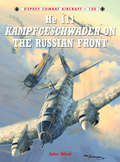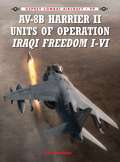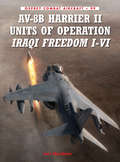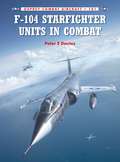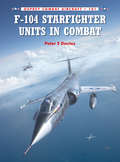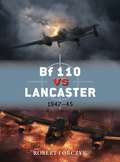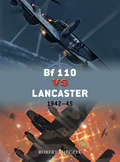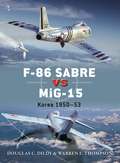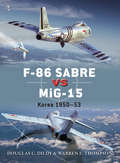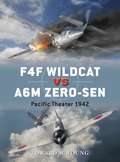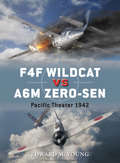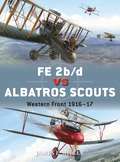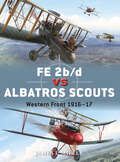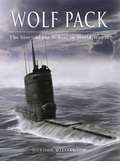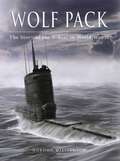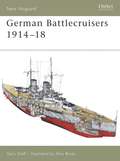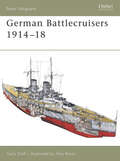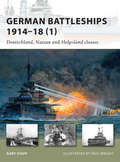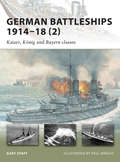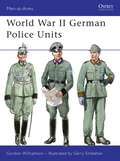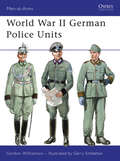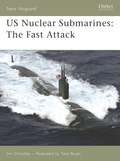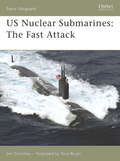- Table View
- List View
He 111 Kampfgeschwader on the Russian Front (Combat Aircraft #100)
by John WealThe twin-engined He 111 was the mainstay of the Luftwaffe's bomber arm at the start of World War ll. Accompanied by the Ju 87 Stuka dive-bomber, it provided the aerial striking power for all the early Blitzkrieg campaigns, sweeping all before it throughout the first 12 months of hostilities. Although it was found wanting when faced by the RAF during the Battle of Britain, it gained new renown on the Eastern Front. The He 111 bomber was in action against the Russians from the first day of the war until the last. It played a part in all the major battles and was employed in a wide variety of roles, including operating as a strategic bomber, torpedo-bomber (over both the Arctic Ocean and the Black Sea), train-buster, interim nightfighter and, latterly, as an auxiliary transport.
He 111 Kampfgeschwader on the Russian Front (Combat Aircraft #100)
by John WealThe twin-engined He 111 was the mainstay of the Luftwaffe's bomber arm at the start of World War ll. Accompanied by the Ju 87 Stuka dive-bomber, it provided the aerial striking power for all the early Blitzkrieg campaigns, sweeping all before it throughout the first 12 months of hostilities. Although it was found wanting when faced by the RAF during the Battle of Britain, it gained new renown on the Eastern Front. The He 111 bomber was in action against the Russians from the first day of the war until the last. It played a part in all the major battles and was employed in a wide variety of roles, including operating as a strategic bomber, torpedo-bomber (over both the Arctic Ocean and the Black Sea), train-buster, interim nightfighter and, latterly, as an auxiliary transport.
AV-8B Harrier II Units of Operation Iraqi Freedom I-VI (Combat Aircraft #99)
by Jim Laurier Lon NordeenThe AV-8B Harrier was, and still is, the only tactical aircraft that can deploy with the US Marine Corps on amphibious assault ships and provide air cover and close air support separate from large deck aircraft carriers. Having seen action during Operation Desert Storm in 1991, the Harrier II returned to the theatre from March 2003 as part of Operation Iraqi Freedom. In the initial conflict some 76 AV-8Bs were deployed, providing more than 40 per cent of the 3rd Marine Air Wing's fixed-wing offensive firepower. Around 60 of these aircraft were sea-based aboard four 'Harrier Carriers', while a unit flew jets from Ahmed al Jaber, in Kuwait. Unlike in 1991, when Harrier IIs employed unguided weapons, 79 per cent of the ordnance dropped was precision-guided. This was primarily due to the AV-8B's upgrading to Night Attack or radar-equipped configuration, and the introduction of the Litening II targeting pod. Following the occupation of Iraq by Coalition troops, Harrier IIs remained in-theatre supporting anti-insurgent operations through to 2008 as part of OIF II-VI.
AV-8B Harrier II Units of Operation Iraqi Freedom I-VI (Combat Aircraft #99)
by Jim Laurier Lon NordeenThe AV-8B Harrier was, and still is, the only tactical aircraft that can deploy with the US Marine Corps on amphibious assault ships and provide air cover and close air support separate from large deck aircraft carriers. Having seen action during Operation Desert Storm in 1991, the Harrier II returned to the theatre from March 2003 as part of Operation Iraqi Freedom. In the initial conflict some 76 AV-8Bs were deployed, providing more than 40 per cent of the 3rd Marine Air Wing's fixed-wing offensive firepower. Around 60 of these aircraft were sea-based aboard four 'Harrier Carriers', while a unit flew jets from Ahmed al Jaber, in Kuwait. Unlike in 1991, when Harrier IIs employed unguided weapons, 79 per cent of the ordnance dropped was precision-guided. This was primarily due to the AV-8B's upgrading to Night Attack or radar-equipped configuration, and the introduction of the Litening II targeting pod. Following the occupation of Iraq by Coalition troops, Harrier IIs remained in-theatre supporting anti-insurgent operations through to 2008 as part of OIF II-VI.
F-104 Starfighter Units in Combat (Combat Aircraft #101)
by Rolando Ugolini Gareth Hector Peter E. DaviesThis title covers the technical characteristics of the F-104 Starfighter, one of the most widely-used and popular aircraft in history. Although built in small numbers for the USAF, the F-104C fought and survived for almost three years in Vietnam. There, it was engaged in some of the war's most famous battles including the legendary operation Bolo, where seven North Vietnamese MiGs were destroyed without the loss of a single US fighter. This small, tough and very fast fighter, dubbed 'The Missile with a Man in It', was called upon to do things it was not specifically designed for, and did them admirably. Featuring illustrations and photographs detailing the variety of nose-paint schemes and weapons configurations, this comprehensive appraisal of the F-104 Starfighter is ideal for modelling and aviation enthusiasts alike.
F-104 Starfighter Units in Combat (Combat Aircraft #101)
by Rolando Ugolini Gareth Hector Peter E. DaviesThis title covers the technical characteristics of the F-104 Starfighter, one of the most widely-used and popular aircraft in history. Although built in small numbers for the USAF, the F-104C fought and survived for almost three years in Vietnam. There, it was engaged in some of the war's most famous battles including the legendary operation Bolo, where seven North Vietnamese MiGs were destroyed without the loss of a single US fighter. This small, tough and very fast fighter, dubbed 'The Missile with a Man in It', was called upon to do things it was not specifically designed for, and did them admirably. Featuring illustrations and photographs detailing the variety of nose-paint schemes and weapons configurations, this comprehensive appraisal of the F-104 Starfighter is ideal for modelling and aviation enthusiasts alike.
Bf 110 vs Lancaster: 1942–45 (Duel)
by Jim Laurier Robert Forczyk Gareth HectorThe RAF introduced the Avro Lancaster in 1942 and used it to spearhead this aerial offensive. In response, the Luftwaffe created an elite nightfighter force based primarily upon the Bf 110. The Luftwaffe was quick to equip it with airborne radar that allowed it to intercept and destroy Lancasters over Germany. In turn, the RAF adopted countermeasures such as the Monica rearward-looking radar to alert Lancaster crews to the approach of nightfighters. In May 1943 the Luftwaffe suddenly developed a novel technical and tactical approach to attacking RAF bombers. The new tactic proved amazingly successful, and British bombers could be attacked from below with no warning. For its part, the RAF failed to detect the new German tactic for six crucial months, during which time its Lancaster bombers were almost defenceless against this new threat. In time, however, the German advantage of surprise was lost and the RAF developed countermeasures to deal with the new threat. The duel between upgraded Bf 110s and Lancasters in the night skies over Germany became increasingly dominated by cutting-edge technology, which would determine the efficacy of strategic bombing.
Bf 110 vs Lancaster: 1942–45 (Duel #51)
by Jim Laurier Robert Forczyk Gareth HectorThe RAF introduced the Avro Lancaster in 1942 and used it to spearhead this aerial offensive. In response, the Luftwaffe created an elite nightfighter force based primarily upon the Bf 110. The Luftwaffe was quick to equip it with airborne radar that allowed it to intercept and destroy Lancasters over Germany. In turn, the RAF adopted countermeasures such as the Monica rearward-looking radar to alert Lancaster crews to the approach of nightfighters. In May 1943 the Luftwaffe suddenly developed a novel technical and tactical approach to attacking RAF bombers. The new tactic proved amazingly successful, and British bombers could be attacked from below with no warning. For its part, the RAF failed to detect the new German tactic for six crucial months, during which time its Lancaster bombers were almost defenceless against this new threat. In time, however, the German advantage of surprise was lost and the RAF developed countermeasures to deal with the new threat. The duel between upgraded Bf 110s and Lancasters in the night skies over Germany became increasingly dominated by cutting-edge technology, which would determine the efficacy of strategic bombing.
F-86 Sabre vs MiG-15: Korea 1950–53 (Duel)
by Jim Laurier Doug Dildy Warren Thompson Wiek LuijkenAs the routed North Korean People's Army (NKPA) withdrew into the mountainous reaches of their country and the People's Republic of China (PRC) funneled in its massive infantry formations in preparation for a momentous counter-offensive, both lacked adequate air power to challenge US and UN. Reluctantly, Josef Stalin agreed to provide the requisite air cover, introducing the superior swept-wing MiG-15 to counter the American's straight-wing F-80 jets. This in turn prompted the USAF to deploy its very best – the F-86A Sabre – to counter this threat. Thus began a two-and-a-half-year struggle in the skies known as “MiG Alley.” In this period, the unrelenting campaign for aerial superiority witnessed the introduction of successive models of these two revolutionary jets into combat. This meticulously researched study not only provides technical descriptions of the two types and their improved variants, complete with a “fighter pilot's assessment” of these aircraft, but also chronicles the entire scope of their aerial duel in “MiG Alley” by employing the recollections of the surviving combatants – including Russian, Chinese, and North Korean pilots – who participated.
F-86 Sabre vs MiG-15: Korea 1950–53 (Duel)
by Jim Laurier Doug Dildy Mr Warren Thompson Wiek LuijkenAs the routed North Korean People's Army (NKPA) withdrew into the mountainous reaches of their country and the People's Republic of China (PRC) funneled in its massive infantry formations in preparation for a momentous counter-offensive, both lacked adequate air power to challenge US and UN. Reluctantly, Josef Stalin agreed to provide the requisite air cover, introducing the superior swept-wing MiG-15 to counter the American's straight-wing F-80 jets. This in turn prompted the USAF to deploy its very best – the F-86A Sabre – to counter this threat. Thus began a two-and-a-half-year struggle in the skies known as "MiG Alley.†? In this period, the unrelenting campaign for aerial superiority witnessed the introduction of successive models of these two revolutionary jets into combat. This meticulously researched study not only provides technical descriptions of the two types and their improved variants, complete with a "fighter pilot's assessment†? of these aircraft, but also chronicles the entire scope of their aerial duel in "MiG Alley†? by employing the recollections of the surviving combatants – including Russian, Chinese, and North Korean pilots – who participated.
F4F Wildcat vs A6M Zero-sen: Pacific Theater 1942 (Duel #54)
by Jim Laurier Gareth Hector Edward M. YoungThe Grumman F4F Wildcat and the Mitsubishi A6M Zero-sen were contemporaries, although designed to very different requirements. The Wildcat, ruggedly built to survive the rigors of carrier operations, was the best carrier fighter the US Navy had available when the USA entered World War II, and it remained the principal fighter for the US Navy and the US Marine Corps until 1942–43. With a speed greater than 300mph, exceptional manoeuvrability, long range, and an impressive armament the slick Zero-sen could out-perform any Allied fighter in 1941–42. The battles between the Wildcat and the Zero-sen during 1942 represent a classic duel in which pilots flying a nominally inferior fighter successfully developed air-combat tactics that negated the strengths of their opponent.
F4F Wildcat vs A6M Zero-sen: Pacific Theater 1942 (Duel #54)
by Jim Laurier Gareth Hector Edward M. YoungThe Grumman F4F Wildcat and the Mitsubishi A6M Zero-sen were contemporaries, although designed to very different requirements. The Wildcat, ruggedly built to survive the rigors of carrier operations, was the best carrier fighter the US Navy had available when the USA entered World War II, and it remained the principal fighter for the US Navy and the US Marine Corps until 1942–43. With a speed greater than 300mph, exceptional manoeuvrability, long range, and an impressive armament the slick Zero-sen could out-perform any Allied fighter in 1941–42. The battles between the Wildcat and the Zero-sen during 1942 represent a classic duel in which pilots flying a nominally inferior fighter successfully developed air-combat tactics that negated the strengths of their opponent.
FE 2b/d vs Albatros Scouts: Western Front 1916–17 (Duel)
by Jim Laurier Mark Postlethwaite James F. MillerIn the spring of 1916 the deployment of the RFC's FE 2 – with its rotary engine 'pusher' configuration affording excellent visibility for its pilot and observer, and removing the need for synchronized machine guns – helped wrest aerial dominance from Imperial Germany's Fokker Eindecker monoplanes, and then contributed to retaining it throughout the Somme battles of that fateful summer. However, by autumn German reorganization saw the birth of the Jagdstaffeln (specialised fighter squadrons) and the arrival of the new Albatros D scout, a sleek inline-engined machine built for speed and twin-gun firepower. Thus, for the remainder of 1916 and well into the next year an epic struggle for aerial superiority raged above the horrors of the Somme and Passchendaele battlefields, pitting the FE 2 against the better-armed and faster Albatros scouts that were focused on attacking and destroying their two-seater opponents. In the end the Germans would regain air superiority, and hold it into the following summer with the employment of their new Jagdgeschwader (larger fighter groupings), but the FE 2 remained a tenacious foe that inflicted many casualties – some of whom were Germany's best aces (including 'The Red Baron').
FE 2b/d vs Albatros Scouts: Western Front 1916–17 (Duel #55)
by James F. MillerIn the spring of 1916 the deployment of the RFC's FE 2 – with its rotary engine 'pusher' configuration affording excellent visibility for its pilot and observer, and removing the need for synchronized machine guns – helped wrest aerial dominance from Imperial Germany's Fokker Eindecker monoplanes, and then contributed to retaining it throughout the Somme battles of that fateful summer. However, by autumn German reorganization saw the birth of the Jagdstaffeln (specialised fighter squadrons) and the arrival of the new Albatros D scout, a sleek inline-engined machine built for speed and twin-gun firepower. Thus, for the remainder of 1916 and well into the next year an epic struggle for aerial superiority raged above the horrors of the Somme and Passchendaele battlefields, pitting the FE 2 against the better-armed and faster Albatros scouts that were focused on attacking and destroying their two-seater opponents. In the end the Germans would regain air superiority, and hold it into the following summer with the employment of their new Jagdgeschwader (larger fighter groupings), but the FE 2 remained a tenacious foe that inflicted many casualties – some of whom were Germany's best aces (including 'The Red Baron').
Wolf Pack: The Story of the U-Boat in World War II
by Gordon WilliamsonGermany's World War II U-Boat fleet represented the elite of their naval personnel. In terms of technology, training, tactics and combat successes, the U-Boat Waffe was far superior to that of any other combatant nation. In this comprehensive book, the wartime development of the U-Boat is traced along with the experiences of typical U-Boat crewmen, from recruitment to combat. The author examines the operational tactics of the U-Boat fleet, as well as describing the massive bunkers that housed them. 'Wolf Pack' contains material taken from Fortress 3: 'U-Boat Bases and Bunkers 1941-45', Warrior 36: 'Grey Wolf: U-Boat Crewman of World War II' and New Vanguards 51 and 55: 'Kriegsmarine U-Boat 1939-45 (1) and (2)', with the addition of a new section on wartime tactics.
Wolf Pack: The Story of the U-Boat in World War II (General Military Ser.)
by Gordon WilliamsonGermany's World War II U-Boat fleet represented the elite of their naval personnel. In terms of technology, training, tactics and combat successes, the U-Boat Waffe was far superior to that of any other combatant nation. In this comprehensive book, the wartime development of the U-Boat is traced along with the experiences of typical U-Boat crewmen, from recruitment to combat. The author examines the operational tactics of the U-Boat fleet, as well as describing the massive bunkers that housed them. 'Wolf Pack' contains material taken from Fortress 3: 'U-Boat Bases and Bunkers 1941-45', Warrior 36: 'Grey Wolf: U-Boat Crewman of World War II' and New Vanguards 51 and 55: 'Kriegsmarine U-Boat 1939-45 (1) and (2)', with the addition of a new section on wartime tactics.
Samurai Women 1184–1877 (Warrior #151)
by Giuseppe Rava Dr Stephen TurnbullFrom when the Empress Jingo-kogo led an invasion of Korea while pregnant with the future Emperor Ojin, tales of female Japanese warriors have emerged from Japan's rich history. Using material that has never been translated into English before, this book presents the story of Japan's female warriors for the first time, revealing the role of the women of the samurai class in all their many manifestations, investigating their weapons, equipment, roles, training and belief systems. Crucially, as well as describing the women who were warriors in their own right, like Hauri Tsuruhime and the women of Aizu, this book also looks at occasions when women became the power behind the throne, ruling and warring through the men around them.
German Battlecruisers 1914–18 (New Vanguard)
by Tony Bryan Gary StaffThe task of Germany's new Große Kreuzer at the beginning of the 20th century was to form an independent reconnaissance division that was able to perform special tasks. With a speed superiority of at least 3 knots, they should also be capable of fighting in the line, and would thus require heavy armour and good defensive qualities. The battlecruisers that were built did indeed have a remarkable ability to withstand battle damage, as demonstrated by the Goeben, which suffered five mine hits on one occasion. This title details all the classes of German battlecruiser, with particular emphasis on each individual ship's battle experience and deployment in conflict.
German Battlecruisers 1914–18 (New Vanguard #124)
by Gary StaffThe task of Germany's new Große Kreuzer at the beginning of the 20th century was to form an independent reconnaissance division that was able to perform special tasks. With a speed superiority of at least 3 knots, they should also be capable of fighting in the line, and would thus require heavy armour and good defensive qualities. The battlecruisers that were built did indeed have a remarkable ability to withstand battle damage, as demonstrated by the Goeben, which suffered five mine hits on one occasion. This title details all the classes of German battlecruiser, with particular emphasis on each individual ship's battle experience and deployment in conflict.
German Battleships 1914–18: Deutschland, Nassau and Helgoland classes (New Vanguard #164)
by Gary StaffThis volume covers the history of the Deutschland to Osfriesland classes of German battlecruisers, beginning with the last of the pre-dreadnought battleships and explaining the revolutionary developments, particularly the vast increases in size and armament, that took place within the German Imperial Navy as it readied itself for war. Gary Staff describes the design and technology of these classes, focusing on the development and combat experiences of individual ships. Supported by official documents, first-hand accounts and drawings, this book also contains specially commissioned artwork depicting the battleship Pommern fighting at Jutland and ships of the Osfriesland class destroying HMS Black Prince in a dramatic night-time engagement.
German Battleships 1914–18: Kaiser, König and Bayern classes (New Vanguard #167)
by Gary Staff Mr Paul WrightSupported by official documents, personal accounts, official drawings and specially commissioned artwork, this volume is an informative history of the key classes Kaiser, König and Bayern that formed the backbone of the German Imperial Navy throughout World War I, detailing the technological revolution that had taken place to enable the building of these large dreadnought classes.
World War II German Police Units (Men-at-Arms)
by Gerry Embleton Gordon WilliamsonThe German Police were an essential arm of the Nazi regime; as soon as Hitler achieved power the previous decentralized provincial system was unified into a single state apparatus, integrated at the command levels with the SS. While it may have been centrally controlled, it was still separated into a bewildering range of different departments and functions, many with their own uniform distinctions. This book offers a concise introduction to the organization, responsibilities, uniforms and insignia of the various branches of this machinery of repression, from Police generals to rural constables, transport policemen and factory watchmen.
World War II German Police Units (Men-at-Arms #434)
by Gordon WilliamsonThe German Police were an essential arm of the Nazi regime; as soon as Hitler achieved power the previous decentralized provincial system was unified into a single state apparatus, integrated at the command levels with the SS. While it may have been centrally controlled, it was still separated into a bewildering range of different departments and functions, many with their own uniform distinctions. This book offers a concise introduction to the organization, responsibilities, uniforms and insignia of the various branches of this machinery of repression, from Police generals to rural constables, transport policemen and factory watchmen.
US Nuclear Submarines: The Fast Attack (New Vanguard)
by Tony Bryan Jim ChristleyThe adoption of nuclear power revolutionized submarine design and means that vessels can stay underwater for months, trailing the enemy or training weapons on land targets from secret positions, "always there, never seen.†? Jim Christley, a former submariner, explores here the influence of Admiral Hyman Rickover in cautiously introducing these stealthy machines of war, and frankly discusses the power and perils of using nuclear reactors at sea. Using unique and detailed artwork, he outlines the many evolving aspects of design within the submarine classes, from the very first nuclear submarine, USS Nautilus, to the classes under construction even now.
US Nuclear Submarines: The Fast Attack (New Vanguard #138)
by Tony Bryan Jim ChristleyThe adoption of nuclear power revolutionized submarine design and means that vessels can stay underwater for months, trailing the enemy or training weapons on land targets from secret positions, "always there, never seen.†? Jim Christley, a former submariner, explores here the influence of Admiral Hyman Rickover in cautiously introducing these stealthy machines of war, and frankly discusses the power and perils of using nuclear reactors at sea. Using unique and detailed artwork, he outlines the many evolving aspects of design within the submarine classes, from the very first nuclear submarine, USS Nautilus, to the classes under construction even now.

